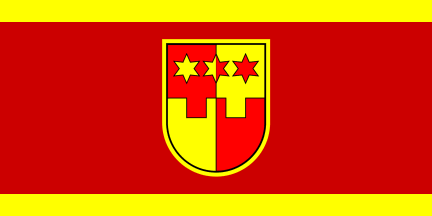
image by Željko Heimer, 12 January 2007

Last modified: 2010-02-19 by dov gutterman
Keywords: krapina | zagorje | croatia | county | krapinsko-zagorska | zupanija | ivancica | daisy |
Links: FOTW homepage |
search |
disclaimer and copyright |
write us |
mirrors

image by Željko Heimer, 12 January 2007
See also:
Cities:
Communities:
Other Sites:
The County of Krapina - Zagorje is situated north of Zagreb,
towards Slovenian border. The area is considered as a typical
rural surrounding of the capital, although it is industrialized,
mostly with light industry. On numerous hills there are many
medieval and baroque castles and parks, and the coat of arms is
therefore rightly chosen. There is a core of one of the three
main Croatian dialects there, called 'kaykavian' (kajkavski).
Željko Heimer, 21 October 1998
I just received mail from Krapinsko-zagorska zupanija,
confirming that they have recently adopted a new flag, as
indicated on Janko
Ehrlich's site. They are expecting this flag to be approved
by central administration
Željko Heimer, 10 March 2000
The flag is red with yellow stripes allong upper and lower
edge (width 1/10 of hoist each). In the middle there is the Coat
of Arms bordered yellow. Ratio 1:2. Adopted: 21 December 1999.
One should note that there are three different shades of red used
in those flags, maybe to visualise possible difference of the
materials used (?) :
CMYK 0 80 100 0 - red fields in Coat of Arms
CMYK 10 100 100 0 - red field of the flag
CMYK 20 100 100 5 - red field of The Ceremonial
Flag
Yellow is in all flags the same Pantone Process Yellow (that's
CMYK 0 0 100 0). But on the ceremonial flag for the linden fruit
are used other two shade Pantone 122 CV (for "berries")
and Pantone 1205 CV (for the "leaf").
Željko Heimer , 24 March 2000
The first set of symbols was adopted by the County already in 1993 (the counties were formed in the beginning
of 1993), adopting the design based on the coat of arms of its
capital city.
I translate the artcile 8 of the decision (1): "The central
part of the coat of arms represents the Old City [of Krapina]
with towers in shape of the shield of the coat of arms of the
City of Krapina. The background of the towers is dark blue.
Around the shield is a mantle of red colour based on the old
uniforms of Croatian soldiers, espeically the Illirians. The
inner part of the mantle is celestial blue, symbolizing the
openness and honesty as well as the integrity of the inhabitants
of the County. On the left and the right of the shield across the
mantle are hanging on golden ribbons the daisy flowers
symbolizing the County and the mountain in which slopes the
County is setteled for the most part. Atop the shield in the
mantle is set the coat of arms of the Republic of Croatia. Behind
the coat of arms above the mantle are stylized low hills of
Zagorje. Below the coat of arms is set a winding ribbon of drak
blue inscribed with "ŽUPANIJA KRAPINSKO
ZAGORSKA"."
The flag is described in article 9, as vertical flag made of red
silk with two square indentations at the base, the size of which
is 1/5 of the flag width. It is fringed with gold. The coat of
arms is set in the lower half, touching the line that divides the
flag in halves, the size of the coat of arms should be such that
the blue ribbon almost touches the vertical edges. (Actually, it
is hard to place the coat of arms in the lower half and then to
make it so big so that ribbons "almost touch" the edges
- of course, it depends what do one means with
"almost"). The horizontal flag was not prescribed, but
was reportedly in use with the coat of arms in the middle and
woithout the indentations.
The decision (2) of 1994 changes only one line of the 1993
decision regarding who gives grants for the use of the symbols to
tohers then the County itself (County chief in 1993, Assembly in
1994).
The 1993 symbols were not approved by the central authorities (at
the time it was in the Ministry of Administration), and the
reasons for that were several (inclusion of the coat of arms of
Croatia in the design, use of the mantle, use of the coat of arms
of the city, ribbons...). So in 1997 the County made a minor
adjustment in hope to get the approval, however this was not
enough to cover for all the flaws in the design. Nevertheless,
the decision (3) of 1997 changes the coat of
arms of the Republic of Croatia atop of the main shield into
"the historic coat of arms of the Republic [sic!] of Croatia
from year 1495". Let's for the moment ignore that
there was no such Republic in 1495, the history of the Croatian
coat of arms knows of two coat of arms preserved from that year
or close to it. Namely a rectangular 8x8 "chess-board"
is preserved on the walls of the church of St. Lucia in Jurandvor
near Baška (important as the site of an other stone carving
showing the oldest preserved text in Glagolitic script) and is
dated around 1495. However, this is probably not the one meant by
the Krapina- Zagorje County legislators - the other coat of arms
is the one preserved on the ceiling of the Stadtrichter Zeller
Haus (Herzog Friedrichstr. 35) of the city magistrate
(Stadtrichter) in Innsbruck, Austria, dating from 1495/96.
[photos of both and some other old Croatian coat of arms could be
seen at <www.croatianhistory.net>].
This coat of arms consists of 4x4 cheqy topped with a golden
simple crown. I redraw the coat of arms according to this,
however I have some reservations weather the 4x4 coat of arms was
really meant - in any case, this should be considered
reconstruction based on description until it is further
confirmed. Nothing else was changed in the previous decisions,
however, during the 1997 the county was renamed to
"Krapinsko- zagorska županija" by some general act
(which assumingly changed all the other county acts by default),
so we may assume that the inscribed name was also changed.
So far, I was not aware that these flags were actually ever made
and I am also suspicious if the coat of arms was used to any
extent, but they were prescribed so. I don't include the
horizontal flag as it was not prescribed, nor reported in use.
The new symbols were finally adopted in 1999 after a public
competition. The decision (4) of 1999 adopts the current symbols
- coat of arms and the flag. The decision changes the description
of the coat of arms and the flag in the previous decisions and
introduces the concept of the ceremonial flag to be determined
with a separate decision. The coat of arms is described so:
"semicircular shield vertically divided. It is heorizontally
divided with embatteled divisions producing four fields in the
shield. Fields one and four are red and two and three are golden.
In the chief are three six-pointed stars, the first one golden,
the second one virtically divided into golden to the left and red
to the right and the third star is red." I prefer a blazon,
for example such: per pale and per bend the latter embatteled
gules and or and overall in chief three six-pointed stars
counterchanged. The flag is bicolour, so that the main part of
the field is dark red while the stripes along the top and the
bottom are yellow ("golden" states the decision), each
having width 1/10 of the flag width. In the middle is the coat of
arms bordered golden. The red of the coat of arms is lighter then
the red of the flag, is explicitly stated in the description. I
received a Corel file from the County, showing these symbols
together with the ceremonial flag - however
that flag differed from the one that was actually adopted,
something I got info only a year latter. The ceremonial flag I
showed in several places was based on that and was errorneous -
it must have been a proposal changed at the very last minute for
the version with the wattle.
The decision (5) was adopted on the same day as the previous one,
defining the ceremonial flag that includes the wattle below the
coat of arms. We know that there are table flags repoirted in use
having the same basic design.
The document listed as (6) above is mentioned in the decision (8)
as one of the decisions being abrogated. By its name, it includes
only a correction of a typo or something like that.
Unfortunately, I am not having the full text of that document
The document (7) is the decision of the Ministry of Justice,
Administration and Local Self-Administration (this was
responsible for the approval of the symbols at the time). It is
referenced in the decision (8), but I have not located the full
text. The reference is interesting to use, as it showes that the
symbols were approved in 2000, 8th May.
And finally, we come to the recent new decision (8), abbrograting
all previous. This is available on the counyt official gazette
site. The decision is for the most part the consolidated text
of the previous decisions. If it were not for the interesting
references and citation of all previous decisions, it would be
fairly uninteresting.
Legislation:
1) Odluka o opisu i uporabi grba i zastave Krapinsko-zagorske
županije, 6. kolovoza 1993, Službeni glasnik
Županije Krapinsko- zagorske, br. 8/93, 30.10.1993.
2) Odluka o izmjeni Odluke o opisu i uporabi grba i zastave
Krapinsko- zagorske županije, 3. lipnja 1994, Službeni
glasnik Županije Krapinsko-zagorske, br. 14/94, 04.06.1994.
3) Odluka o izmjeni Odluke o opisu i uporabi grba i zastave
Krapinsko- zagorske županije, 19. prosinca 1997,
Službeni glasnik Krapinsko- zagorske županije, br.
14/97, 22.12.1997.
4) Odluka o izmjenama i dopunama Odluke o opisu i uporabi grba i
zastave Krapinsko-zagorske županije, 17. prosinca 1999,
Službeni glasnik Krapinsko-zagorske županije, br.
17/99.
5) Odluka o izgledu svecane zastave Krapinsko-zagorske
županije, Krapina, 17. prosinca 1999. Kl: 021-04/99-01/168,
Urbr. 2140/1-01-99- 1, Službeni glasnik Krapinsko-zagorske
županije, br. 17/99
6) (Ispravak Odluke, Službeni glasnik Krapinsko-zagorske
županije, br. 1/00.)
7) (Rješenje Ministarstva pravosuda, uprave i lokalne
samouprave Kl. UP/I-017-02/99-01/19 Urbr. 514-09-01-00-2,
08.05.2000.)
8) Statutarna odluka o opisu i uporabi grba i zastave Krapinsko-
zagorske županije, 11. ožujka 2005, Službeni
glasnik Krapinsko- zagorske županije, br. 2/05, 14.03.2005.
Željko Heimer, 12 January 2007
The symbols were designed by the Heraldic Art d.o.o.
company from Rijeka.
Željko Heimer, 4 November 2007
The new Statutes of the Krapina-Zagorje County at <www.kr-zag-zupanija.hr>,
do not describe the symbols only mention them.
However, the agenda
of the 4th session of the county assembly at that was held on 17
December 2009, includes the item on the proposal for amendments
of the decision of the county coa and flag. I suppose that the
amendments are only minor, as in other cases in 2009, amending
only responsibilities of the county mayors in regard with the
grant of use of the symbols to the commercial businesses.
Željko Heimer, 25 December 2009
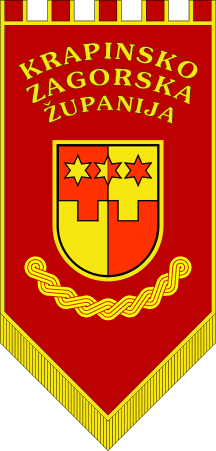
image by Željko Heimer, 8 May 2004
The ceremonial flag is gonfalon with triangual ending, five
sleave rectanges at the top, red bordered with yellow and with
yellow fringe along the lower sides. In the middle is the Coat of
Arms bordered yellow, above it arched inscription bearingh the
name of the community in three lines, below two yellow branches -
a vine with grapes and a linden branch with it's fruit.
Approximate ratio 1:2.
Željko Heimer, 24 March 2000
Above you can read on the ceremonial flag of the Krapina-
Zagorje County as it is described in the original documentation.
However, at least since 2002 there were reported in use table
flags that were different from that design, namely instead of the
branches below the coat of arms, they have an arc of the tripple
wattle.
I believe that until now it was not confirmed weather the real
unique ceremonial flag was also done with the wattle arc, or if
only the table flags are made so.
Željko Heimer, 8 May 2004
There are two reported version of the ceremonial flag of the
County. I just received a definitive confirmation that the one
with the wattle is the one in use and the one with the branches
apparently was never produced. A photo in local magazine Zagorski
list, br.34, 9 June 2004. shows the three flags on display in the
Krapina-Zagorje County Assembly Hall - the middle one is the flag
of Croatia, to its right (viewer's left) is the ceremonial flag
of the county and on the other side is the ceremonial flag of the
city of Krapina. I believe that such display of two ceremonial
flags together is rather unusual, probably the two share the same
assembly hall.
It may be interesting to note that the two flags side by side on
the photo clearly show different rectangular sleaves in the upper
edge. I do not find any specialy meaning in that, but just an
observation.
Željko Heimer, 11 June 2004
There is a decision titled: Odluka o izgledu svecane zastave
Krapinsko-zagorske županije, Krapina, 17. prosinca 1999. Kl:
021-04/99-01/168, Urbr. 2140/1-01-99- 1. The decision made
at the same time when the new 1999 design of the county flag was
made, determines the design of the ceremonial flag as well.
Unlike the ceremonial flag that was at first planned, with two
branches below the coat of arms, the design including the arched
wattle was adopted. Tomislav Šipek already pointed to
me that the table flags are made in the pattern with an arc of
the tripple wattle. I have had that info before the congress in
Stockholm, but after I have sent the final text to the editor.
Therefore I have shown this, what I considered a variation then,
on my presentation in Stockholm, but this is not included in the
proceedings. also, I believe that I have published the errorneous
design in some other publications before that also. Afterwards,
Tomislav confirmed that not only the table flags are made without
the branches, but the real ceremonial flag as well. I finally
found a document to support that The flag with branches is thus
just an unadopted proposal after all.
Željko Heimer, 18 December 2004

image by Željko Heimer , 24 March 2000
kr.gif)
image by Željko Heimer, 8 October 2000
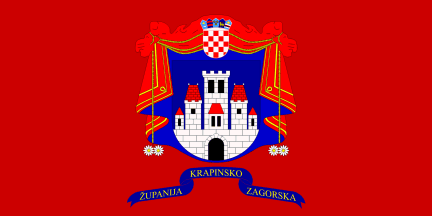
image by Željko Heimer, 12 January 2007
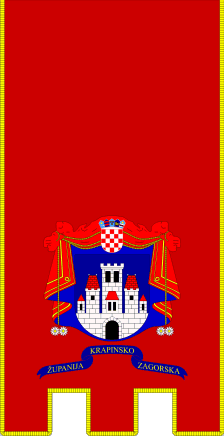
image by Željko Heimer, 12 January 2007
kr9x.gif)
image by Željko Heimer, 8 October 2000
The Coat of Arms of Krapina-Zagorje is variation of the Coat
of Arms of Krapina city, surrounded with the heraldic tent,
"crowned" with the full Coat of Arms of Croatia. There
is no crown here, but surely the state Coat of Arms is
unapproprate here, and certainly forbiden by the law(s).
Željko Heimer, 21 October 1998
Question to flower experts - name a small field flower haing
yellow seeds and small pointed white pettals. In Croatian they
are called "ivanc<ica", clearly connected with
deminutive feminin form of the name "Ivan" (John). I
guess that it is not only the Croatian "stereotype"
that these flowers are used often by young gilrs for making
girdles playing fairy queens and similar.
In any case, when we get the name of the flower - it is that
flower that is shown as four things that hangs from the heraldic
mantly in the former (and never approved) coat of arms of
Krapina-Zagorje county. Those flowers were chose for canting
reasons to remind on the mountain of the same name (Ivanc<ica)
that dominates the County landscape.
Željko Heimer, 10 September 2000
They look to me very much like what we call daisies. They are
a widespread wildflower in America (and probably elsewhere) and
often used by small children here as ornaments.
Al Kirsch, 10 September 2000
I agree with Al's identifiaction, even if it causes me some
linguistical-botanical trouble. Daisy seems to be used in English
both for big and small daisy-like flowers, which belong to two
different botanical species:
- the "big" daisy, Leucanthemum vulgare in Latin,
marguerite in French.
- the "small" daisy, Bellis perennis, paquerette in
French.
The "big" daisy is involved in the game
"effeuiller la marguerite" (litt. to pick the petals
off the daisy), a "she loves me - she loves me not"
game. Every picked petal is associated with a special level of
expected love (from "not at all" to "madly").
The level corresponding to the last petal tells what can be
expected. The game is difficult to play with "small"
daisies, because their petals are too small.
Botanically , daisy flowers are not "flowers" but
"composite inflorescences", specifically called
"capitules" ("small heads in Latin"). The
name of this flower family (including dandelion, artichoke,
cornflower, salsify, thistles ...) was Composaceae, until the new
Botanical Code changed it to Asteraceae (association with a
genius name is now mandatory, so forgot the Graminaceae and other
Cruciferaceae). Both the white "petals" and the yellow
"seeds" of the inflorescence are in fact true flowers,
and the inflorescence is made of hundreds of them. The white
"petals" are in fact the petals of the outer flowers (a
singel petal for each flower), whereas the inner yellow flowers
do not have petals.
Ivan Sache, 10 September 2000
I agree, these are properly known as asters, maybe because
they look like stars?
John S. Ayer, 11 September 2000
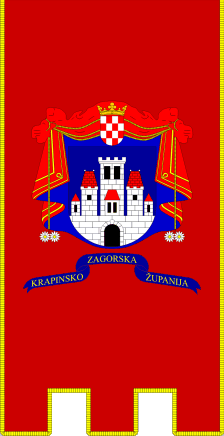
image by Željko Heimer, 12 January 2007
kr97.gif)
image by Željko Heimer, 12 January 2007